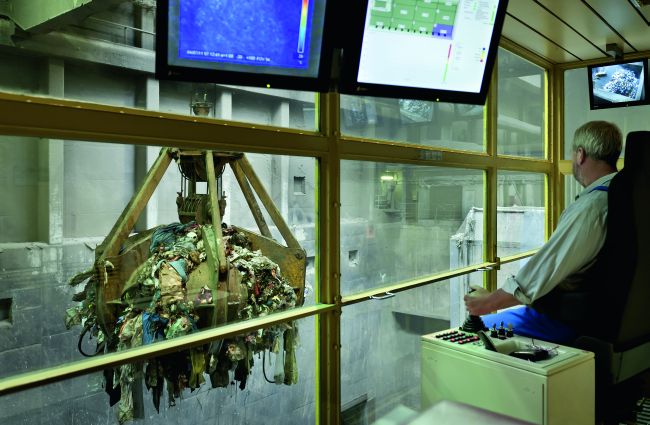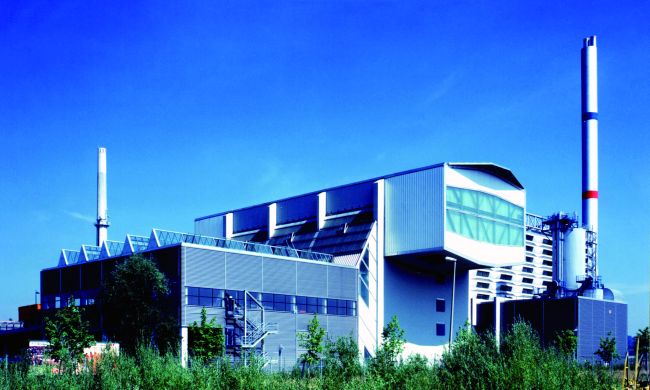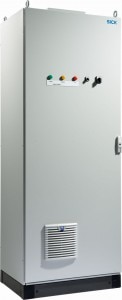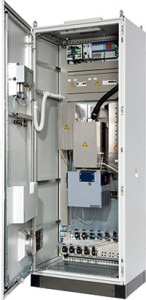Garbage that is burned and converted into power, district heat, and ash releases significantly fewer climate-damaging gases than garbage deposited in landfills. However, the practice of thermal recycling (which converts waste into energy) is also booming because, all over the world, there is an increasing amount of garbage and less landfill space. Across the globe, approximately 230 waste-to-energy plants will soon be added to the 2,200 or so that are currently in operation. The aim is to achieve greater efficiency, lower costs, and reduced CO² emissions through metal recycling, ash treatment, and waste heat recovery. Continuous measuring technology helps to determine efficiency reserves. 
In most cases, garbage is burned on furnace grates at approximately 850°C or by means of fluidized bed combustion after prior treatment. In addition to carbon dioxide, these processes produce a number of other dangerous pollutants, such as carbon monoxide, sulfur dioxide, nitric oxide, hydrochloric acid, hydrofluoric acid, mercury, dust containing heavy metals, and highly toxic substances. Furthermore, non-homogenous waste fractions burn at different rates, clog up plant sections, and can quickly change the flue gas composition. Therefore, measuring technology that is both very reliable and highly sensitive is indispensable, as it provides accurate information on crucial plant parameters.
Waste incineration plant
One of Swedens most state-of-the-art waste incineration plant Tekniska Verken, for example, is required to measure pollutants continually and produce reports for the authorities on a regular basis. The plant uses more than 420,000 tonnes of household garbage to create heating and cooling energy, and has an energy efficiency rate of > 60%.

To monitor processes and pollutants, the operator uses the SICK MCS100E infrared multi-component measuring system, whose features include integrated O² and total carbon measurement as well as in-situ dust measurement and non-contact ultrasonic volume flow rate measurement.
 MCS100E
MCS100E
The MCS100E can simultaneously measure approximately eight pollutants and informs the operator of increases in levels well in advance when measuring untreated gases, thus ensuring that there is enough time to implement countermeasures in the gas cleaning stages. In addition, it saves on calibration gas costs, as the calibrated measuring ranges are checked by swiveling optical filters. The plant management has a redundant back-up system running too, to ensure that no half-hourly values are lost and that failures are avoided. If implausible measured values arise - something that is not uncommon in the fluctuating emissions values experienced in waste incineration plants - this back-up system also serves to validate the measured pollutant concentrations.
Waste-to-energy plant
The largest waste-to-energy plant in the Swiss canton of Valais, the KVA SATOM plant in Monthey, also uses a SICK ulti-component device: the MCS100FT, which has integrated HF monitoring and is based on the Fourier transform measurement principle. In its former life the plant simply destroyed waste, but nowadays it produces metals and energy. Every year, it generates approximately 140 million kWh of electricity and 100,000 tonnes of process steam from around 160,000 tons of municipal waste and 40,000 tons of scrap wood. The 27,000 residents of the neighboring communities receive heat supplied by a dedicated district heating network. The WtE plant has been publically acknowledged for its particularly good carbon footprint and the high level of waste it recycles.
 CEMS-Lösung MCS100FT
CEMS-Lösung MCS100FT
A self-controlling infrared spectrometer from SICK supplies the measured values for this. It monitors the exhaust gas components hydrogen chloride (HCl), ammonia (NH3), carbon monoxide (CO ), sulfur dioxide (SO2), nitric oxide (NO), nitric dioxide (NO2), carbon dioxide (CO 2), and trace amounts of hydrofluoric acid (HF) directly in the chimney. Thanks to the anti-corrosion measurement cell and wear-free ejector, the measuring system achieves a gas flow rate of 400 l/h. The MEAC2000 data acquisition system incorporated into the emission measuring system continually records all incoming values and standardizes all measurements to the legally prescribed O2 reference value of 11% by O2 volume. All data is continually transferred to the WtE plant control system as hourly and daily average values.
- Productinformation: MEAC2000, MCS100FT, MCS100E
- Productportfolio: Analysenlösungen
- Customer information: Tekniska Verken, KVA SATOM Monthey

